| Vellocatus | |
|---|---|
| King of the Brigantes | |
| Reign | c. AD 52 – c. AD 69 |
| Predecessor | Venutius |
| Successor | Venutius |
| Born | c. 1st century AD |
| Died | After c. AD 69 |
| Spouse | Cartimandua |
| Father | Unknown |
| Mother | Unknown |
Vellocatus was a first-century king of the Brigantes tribe of northern Britain.
He was originally armour-bearer to Venutius, husband of Cartimandua, the queen of the Brigantes and an ally of Rome. Some time after 51 AD Cartimandua split with Venutius, divorcing him and marrying Vellocatus and elevating him to kingship. Vellocatus appears to have been a member of the servant class, rather than a noble. According to Roman historian Tacitus "the royal house was immediately shaken by this disgraceful act", as many aristocrats would not accept a former servant as their king. [1]
The former king Venutius was able to gather followers, becoming an important figure in the resistance to Roman occupation. Venutius staged two revolts against Cartimandua, first in the mid-50s, which was defeated by the Romans, and again in 69, this time successfully. Cartimandua was rescued by the Romans as Venutius seized power. Vellocatus's fate is not recorded.
AD 68 (LXVIII) was a leap year starting on Friday of the Julian calendar. At the time, it was known as the Year of the Consulship of Silius Italicus and Trachalus, or the start of the Year of the Four Emperors. The denomination AD 68 for this year has been used since the early medieval period, when the Anno Domini calendar era became the prevalent method in Europe for naming years. These are now used throughout the world.
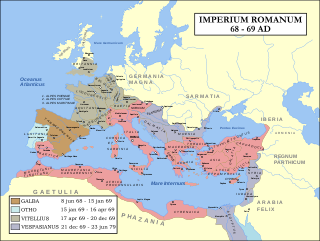
AD 69 (LXIX) was a common year starting on Sunday of the Julian calendar. At the time, it was known as the Year of the Consulship of Augustus and Rufinus. The denomination AD 69 for this year has been used since the early medieval period, when the Anno Domini calendar era became the prevalent method in Europe for naming years.
AD 54 (LIV) was a common year starting on Tuesday of the Julian calendar. At the time, it was known as the Year of the Consulship of Lentulus and Marcellus. The denomination AD 54 for this year has been used since the early medieval period, when the Anno Domini calendar era became the prevalent method in Europe for naming years.

The 50s decade ran from January 1, 50, to December 31, 59. It was the sixth decade in the Anno Domini/Common Era, if the nine-year period from 1 AD to 9 AD is considered as a "decade".

The 60s decade ran from January 1, AD 60, to December 31, AD 69.
AD 57 (LVII) was a common year starting on Saturday of the Julian calendar. At the time, it was known as the Year of the Consulship of Caesar and Piso. The denomination AD 57 for this year has been used since the early medieval period, when the Anno Domini calendar era became the prevalent method in Europe for naming years.

The Roman conquest of Britain was the conquest of the island of Britain by occupying Roman forces. It began in earnest in AD 43 under Emperor Claudius, and was largely completed in the southern half of Britain by 87 when the Stanegate was established. Attempts to conquer Scotland in succeeding centuries met with little sustained success.

Caratacus was a 1st-century AD British chieftain of the Catuvellauni tribe, who resisted the Roman conquest of Britain.
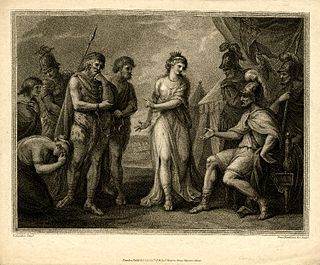
Cartimandua or Cartismandua was a 1st-century queen of the Brigantes, a Celtic people living in what is now northern England. She came to power around the time of the Roman conquest of Britain, and formed a large tribal agglomeration that became loyal to Rome. The only account of her is by the Roman historian Tacitus, through which she appears to have been widely influential in early Roman Britain.

Venutius was a 1st-century king of the Brigantes in northern Britain at the time of the Roman conquest. Some have suggested he may have belonged to the Carvetii, a tribe that probably formed part of the Brigantes confederation.
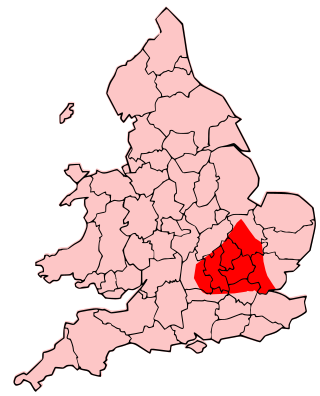
The Catuvellauni were a Celtic tribe or state of southeastern Britain before the Roman conquest, attested by inscriptions into the 4th century.

The Brigantes were Ancient Britons who in pre-Roman times controlled the largest section of what would become Northern England. Their territory, often referred to as Brigantia, was centred in what was later known as Yorkshire. The Greek geographer Ptolemy named the Brigantes as a people in Ireland also, where they could be found around what is now Wexford, Kilkenny and Waterford, while another people named Brigantii is mentioned by Strabo as a sub-tribe of the Vindelici in the region of the Alps.
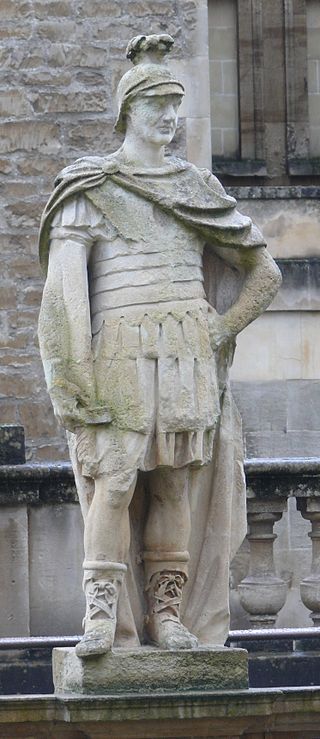
Publius Ostorius Scapula was a Roman statesman and general who governed Britain from 47 until his death, and was responsible for the defeat and capture of Caratacus.
Aulus Didius Gallus was a member of the Roman Senate and general active during the 1st century AD. He held a number of offices and imperial appointments, the most important of which were governor of Britain between 52 and 57 AD, proconsul of Asia, and suffect consul in the nundinium of September to December 39 as the colleague of Domitius Afer.
Marcus Vettius Bolanus was a Roman senator and soldier. He was suffect consul for the nundinium of September-December 66 as the colleague of Marcus Arruntius Aquila.
The final battle in Caratacus's resistance to Roman rule was fought in 50 AD. The Romans under Publius Ostorius Scapula defeated the Britons and in the aftermath captured Caratacus himself, since 43 the leader of armed opposition to the Roman conquest of Britain. He was paraded through Rome and given the opportunity to make a speech before the emperor Claudius, who spared his life and those of his family and retainers.
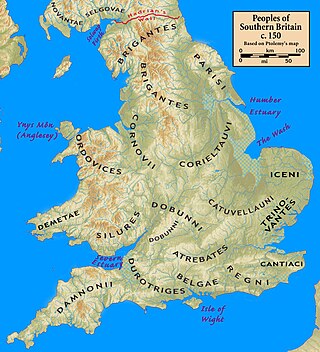
The Roman client kingdoms in Britain were native tribes which chose to align themselves with the Roman Empire because they saw it as the best option for self-preservation or for protection from other hostile tribes. Alternatively, the Romans created some client kingdoms when they felt influence without direct rule was desirable. Client kingdoms were ruled by client kings. In Latin these kings were referred to as rex sociusque et amicus, which translates to "king, ally, and friend". The type of relationships between client kingdoms and Rome was reliant on the individual circumstances in each kingdom.

Stanwick Iron Age Fortifications, a huge Iron Age hill fort, sometimes but not always considered an oppidum, comprising over 9 kilometres (5.6 mi) of ditches and ramparts enclosing approximately 300 hectares of land, are situated in Richmondshire, North Yorkshire, England. Whether Stanwick was the stronghold of Venutius or Cartimandua, or perhaps of them both for a brief time before their acrimonious split some time after 51 AD, it is certain that this settlement was one of the most important in Brigantia, the Brigantes kingdom during the early stages of the Roman occupation of Britain. The site is a scheduled monument.
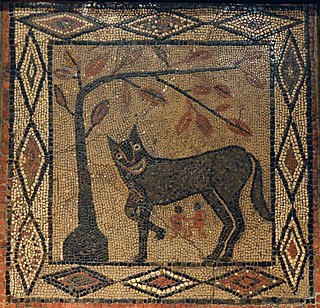
Isurium or Isurium of the Brigantes was a Roman fort and town in the province of Britannia at the site of present-day Aldborough in North Yorkshire, England, in the United Kingdom. Its remains—the Aldborough Roman Site—are in the care of English Heritage.
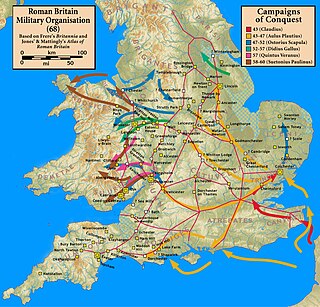
Strutt's Park Roman Fort was a Roman fort in Strutt's Park, a suburb of Derby in Derbyshire, England. It was built around the year 50 and replaced, probably between the years 75 and 80, by a new fort at Little Chester on the opposite bank of the River Derwent.